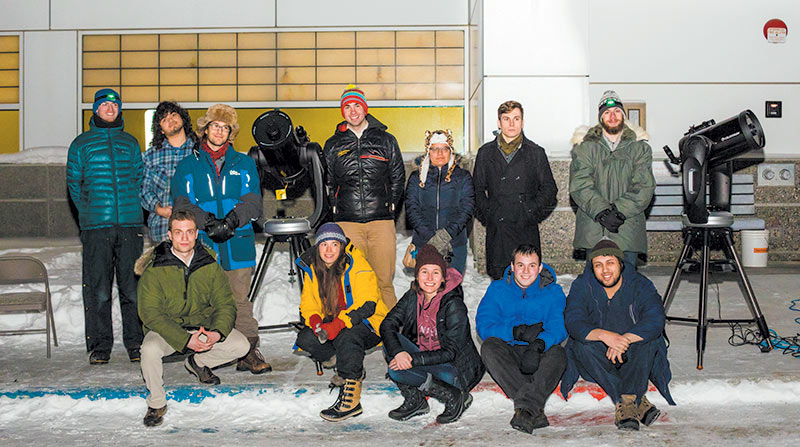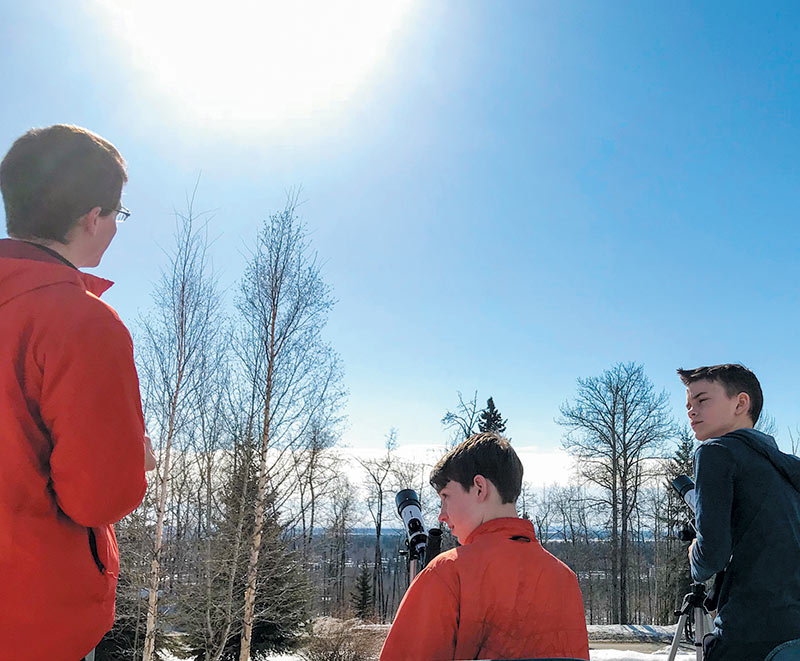Solarpalooza: A Solar Viewing Experience
Solarpalooza: A Solar Viewing Experience
2017–18 Marsh White Award
Project Lead: Riley Troyer
Project Advisor: David Newman
Project Summary: One of the main foci of the University of Alaska Fairbanks (UAF) physics department is space physics. While this subject is a fascinating and important one, getting the general public interested in it can be challenging. To help engage the public with the research being conducted at UAF and space physics in general, the UAF Society of Physics Students held a public solar viewing event.

We decided to include our event in the College of Natural Science and Mathematics’ (CNSM’s) annual Science Potpourri. This is a college-wide event that highlights the diversity of science at the university. Physics always has several stations, but they have been the same demos for several years. This year we changed things up and set up several solar telescopes that we purchased with award funds, a larger Schmidt-Cassegrain telescope, and the “Fabric of the Universe” gravity well demonstration provided in the 2017 SPS SOCK kit.1 The demonstrations combined teaching from physics students and participant interaction with the telescopes and SOCK gravity well.
Because the Science Potpourri has a 20-year history, we had a good idea of the audience to expect. The audience was primarily families with kids between the ages of 3 and 13 but also included community members of all ages. We found that the telescopes were best suited to kids above the age of 8, although many younger kids also enjoyed the demonstrations.
Our first goal with this project was to teach the Fairbanks community about the sun and physics involved with it. More than 100 people stopped by our telescope station and safely viewed the sun, learning a little about sunspots, the aurora, and telescopes. Through our gravitational well demonstration, they learned why the planets orbit the sun. Another goal was to show the community how UAF is involved with solar physics. We don’t feel that this goal was achieved as strongly as it could have been. For future events, we recommend inviting a physics professor to explain their research and make the connection between the sun and UAF research.
A final goal was to add some new physics demos to the UAF CNSM Science Potpourri. We were definitely able to achieve this. Our two biggest demos—the solar telescopes and the gravitational well—were brand new this year. They were very well received, and we plan to set them up again next year.
We estimate that 150–200 people used the solar telescopes over the course of the day. For the overall event, the college estimated that around 1,200 people attended. This let us know that while we reached many people, with a more visible location and more signs we probably could have reached a lot more. In addition, we learned a lot through face-to-face interactions with participants. For instance, we got some complaints and noticed people having trouble with the tripods on the solar telescopes,
so we purchased nicer tripods when the event was finished. However, we also learned that a large majority of the people who attended had never seen the sun through a telescope before and that they were excited to experience it. To build on this enthusiasm, we are planning to lead these activities again next year and supplement our equipment with a hydrogen-alpha solar telescope for even better views of the sun.
1.SOCKS, or Science Outreach Catalyst Kits, are provided free to SPS chapters each year. Check out 2017’s version at https://www.spsnational.org/programs/outreach/science-outreach-catalyst-....
For more information on this project, visit spsnational.org/awards/marsh-w-white-outreach-award/2018/university-alaska-fairbanks. 
